#Minor phyla
Note
Came from that post you have asking for Adam Warlock headcannons, so consider with me:
Him being the best at massages and always going to him after battles when your body is aching and him rubbing your shoulders and back until you fall asleep.
No one can quite relieve the pain like he can. Even if you’ve been taken care of in the med wing, the soreness doesn’t go away until you’re with him.
TLC
Adam Warlock x Reader
Plot: Adam is there to help you with recovery after missions.
Genre: PG-13 (One use of y/n)
A/N: Hello Nonie! What a lovely headcanon and I'm so sorry I only got to this now. I tried to bounce off your idea and make it into a short piece. If you read it, I hope you liked it!

"Adam!"
The young girl runs into his room, hurtling towards him like a cannonball. Adam frowns, hearing the urgency in Phyla's voice.
"What is it?"
"It's y/n. She's-"
Before Phyla could finish her sentence, Adam bolts out of the room, racing down the stairs and towards the ship that had just docked from a mission. Phyla almost smacks into him face first as he abruptly comes to a stop seeing you lying across the table, groaning in pain. Adam is at your side, assessing for any serious injuries.
"You're not injured?"
You raised your eyebrows. "You want me to be?"
"No, sweetheart. I didn't mean that. Phyla told me-"
"I was going to tell you," the youngest interjects. "That she's fine but her back is feeling a little stiff from the ambush by the trogawogs. She sent me to get you to check if it's merely just a stiff back or if it's something else."
Despite your pain, you can't help but smile at the sight of Phyla's confused face and Adam's sheepish reaction.
"Thank you, Phyla. You can go now." You dismiss her and she leaves you and Adam.
"You do give solid massages." You break the silence. "Do you mind?"
"Oh yeah, of course."
Carefully, you prop yourself up. As his fingers press into your skin, you let out a sigh of relief. "Oh... that hits the spot. Could you move up a little? I think one of them may have gotten my shoulder. I just want to make sure it's ok."
Adam quietly gets to work as he expertly undoes the knots that formed in your back.
"You're a saint," you thanked him as he works his magic. "Whatever you want, just say the word. But it'll have to be within my means of course." You quickly add the last part, well aware that you were potentially making a deal with a god. He only chuckles and focuses his pressure on your upper back.
Once satisfied with his work, Adam takes out your pain relief patches that you bought from Earth, applying two of them just as you taught him the very first time. He's about to let you know that he's finished but sees your head drooping slightly.
Having off-world missions back to back wasn't easy and as the human on the team, it definitely took a toll on you compared to the others. Adam wished that you wouldn't take so many missions, but he also knew you were too stubborn and strong-headed to listen.
Lifting you under your back, Adam walks back to your quarters, careful not to wake you up. He makes sure that any other minor injuries are taken care of and finally tucks you to bed. You're out like a light, and into dreamland. He wants to stay a little longer but has his own mission to prepare for. Leaning down, he kisses your forehead.
"Whatever I want... I just want you to not get hurt. That's all I want."
As he takes one last look at your serene face, Adam switches off the light, making a mental promise to visit you when he gets back.
188 notes
·
View notes
Note
Speaking of specevo, have you ever seen the Alien Biospheres series on youtube by Biblaridion? Really fascinating speculative evolutionary history of an entire planet starting all the way at how large the planet is and what its atmosphere is made of and progressing onward.
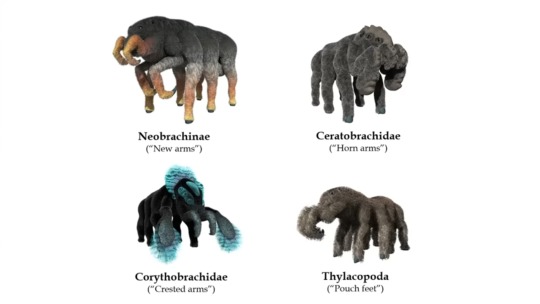
Here are some closely related Guys
Havent watch the series but have seen their stuff around +binged the wiki about it. Projects that go into a timeline of evolution (alien or not) are braver and stronger then me.
My one extremely minor nitpick is that I initially assumed Anthostoma and Polypodia (the main phyla in the project besides the plantlife) were one group, since both have 8 legs 3 eyes and limby mouthparts on their face. On the flip side, spiders and octopi both evolved the same body plan of "8 long limbs on head/face, round legless body behind from radically different groups and they both pull it off.
#Excited to see where the evolution of these critters goes in the future#The twitter account also has some very lovely illustrations for the setting too
38 notes
·
View notes
Text
Funky sapient creatures of assorted phyla
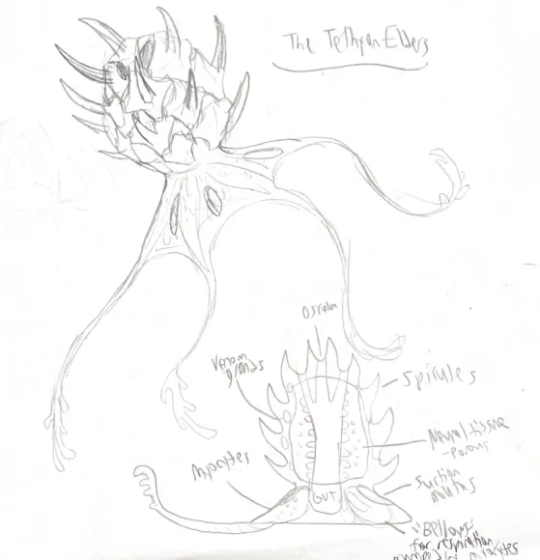
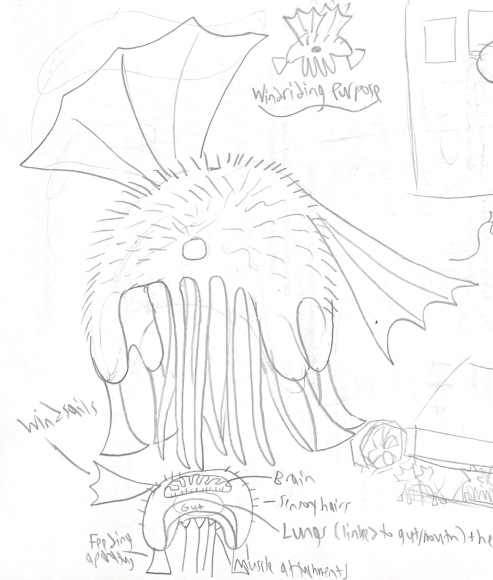

Doing @dimetrodone's 30-day phyla challenge, very very late!
Also, for fun, I was inspired by @danbensen's Fellow Tetrapod, so I sort of crossed the two concepts together and decided to make an alternate-timeline sophont for each phylum on the list.
So! Starting off:
- The Tethyan Elders: Sapient sea sponges. Mostly brain, they're highly intelligent but think slowly. The soft brain is protected by spicules, armed with venom glands. Their civilization has existed for 5 million years, and they fashion decor out of the skeletons their ancestors leave behind. Generally pacifist.
- The Windriding Purpose: Sapient placozoa in a timeline where they evolved dominance. Their brains are entirely mechanically powered, a complex maze of fluids and cilia. A minor change in environmental conditions leads to a shifting of fluids and moving cilia, and hence thought. They are like strandbeest in that they're mostly wind-powered. The fact that the environment can influence thought has led to some very concerning "mind-manipulation" research by various Purpose governments.
- The Bodies Whom Lurk: Intelligent freshwater comb jellies that breathe through gills/their skin like amphibia. Their nervous system is made of fused cells and is decentralized. They are blind. They've been using giant mirrors, constructed via remote-control rovers, to reduce the albedo of the planet, lowering Amazonian temperatures to something generally more Yangtze-like. Inevitably, this led to ecological disaster.
39 notes
·
View notes
Text
need 2 figure out . a tagging system that in one way or another covers Every animal……
thankfully #marine covers like Most phyla. out of 30ish total phyla there are like 14 that are too bizarre and tiny to worry about. i mean tiny in both like quantity of described species and in like actual size. Have you ever seen a placozoan? I bet the Fuck Not. anyways I’ll probably do a worm tag because there are like at least 6 phyla that can be called worms. (22k annelids + >25k nematodes + 20k? flatworms + 1.3k nemertea lol + …..120 chaetognaths + only 22 priapulid worms WHAT. + a few other minor phyla. = like 69k described species lmao nice. don’t take my word for that tho these numbers are super fucking rounded) oh and acorn worms. whatever
ok then there’s. sponges ctenophores cnidarians echinoderms which are all not worms and definitely marine. im not gonna try to do a species count here actually. but that’s all pretty straightforward. bryozoans also in here. No special tag for these guys they’re just marine
chordata is like 65k species in total? and a solid 30k+ are counted under my marine tag. #beasts is for all mammals which is like 6400 extant species (89 cetaceans + 34 pinnipeds + 13 otters + 4 sirenians = 140 mammal species covered by #marine. if we’re being particular.) unfortunately tho I ddddddont yet have tags for amphibians reptiles or birds (except for a frog tag but I haven’t used it in forever and it doesn’t count salamanders. or caecilians can you imagine deliberately excluding those poor guys.) extra note there are several groups of mammals that get their own tags (goats sheep tamanduas and uh like hamspers i think. I would like to tuch it-style domesticated rodents.)
arthropoda is very very large species wise so im absolutely not going to attempt to do any species tallies but! the decision here is that arachnids, hexapods, isopods, and myriapods are in #entomo and everything else is for the time being in #marine. terrestrial crabs go fuck ur selves. marine isopods are in both <3
which brings me to mollusks. now for the most part this is simple. bivalves are marine. cephalopods are marine. chitons are marine. but GASTROPODS. have MANY TERRESTRIAL SPECIES. Including BANANA SLUGS MY DEARLY BELOVED. and I don’t know what I’m going to do about the terrestrial gastropods. and im too tired to decide now. Lol
1 note
·
View note
Text
there's also that phylum of animals that were entirely different from any other animal phylum (Monoblastozoa) with cillia and other stuff, which had only one species, Salinella salve, which was found in some random salt flat in Córdoba (yes, Córdoba, Argentina) and never found again and might not even exist
18 notes
·
View notes
Text

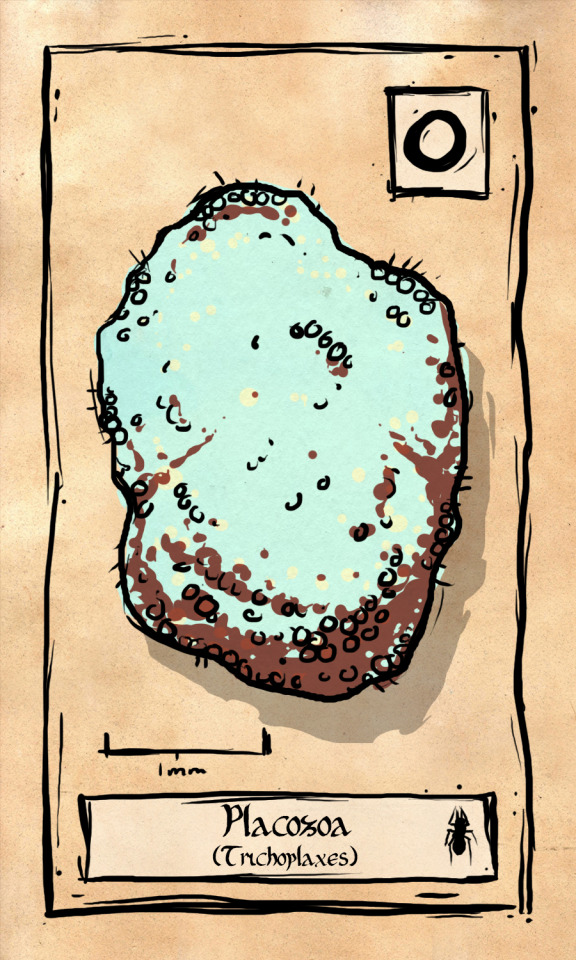
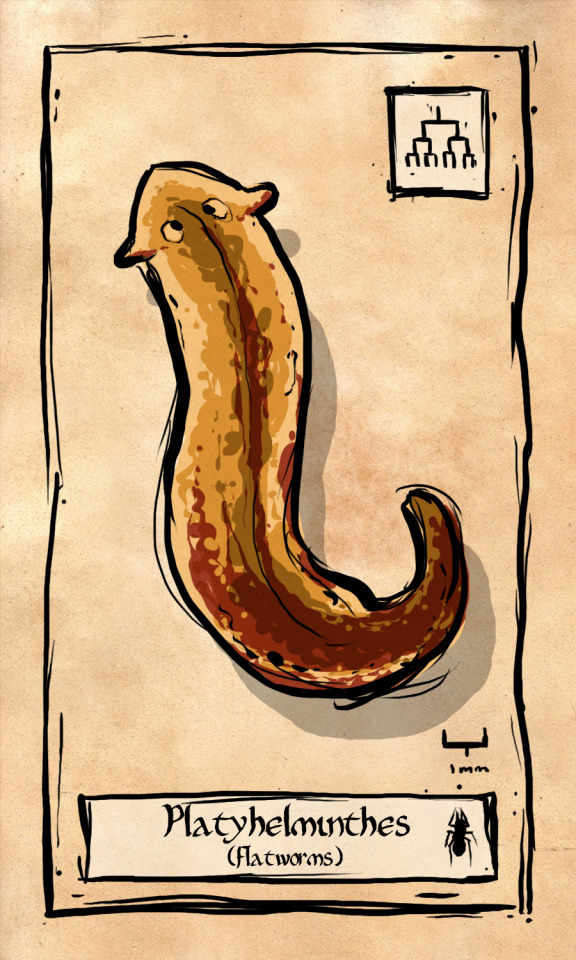
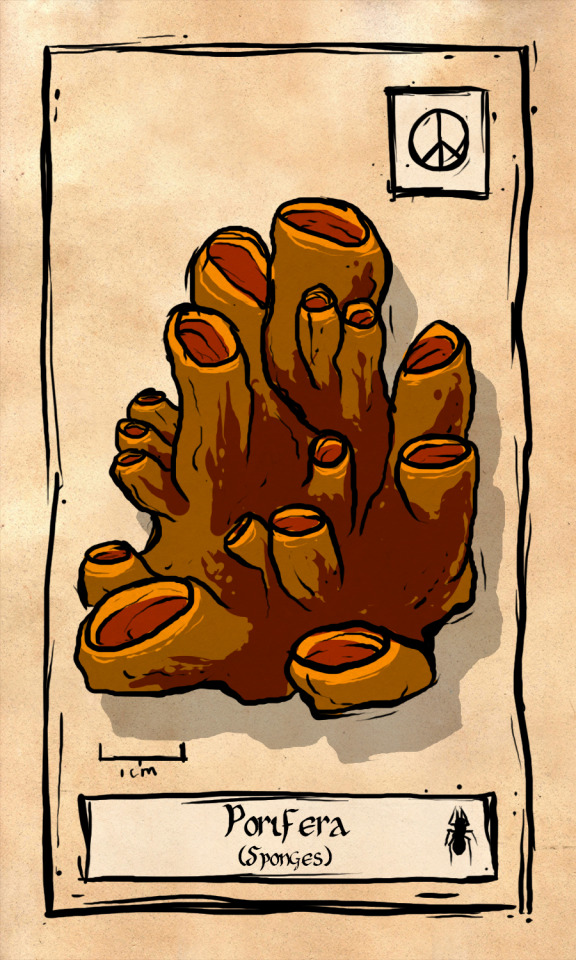

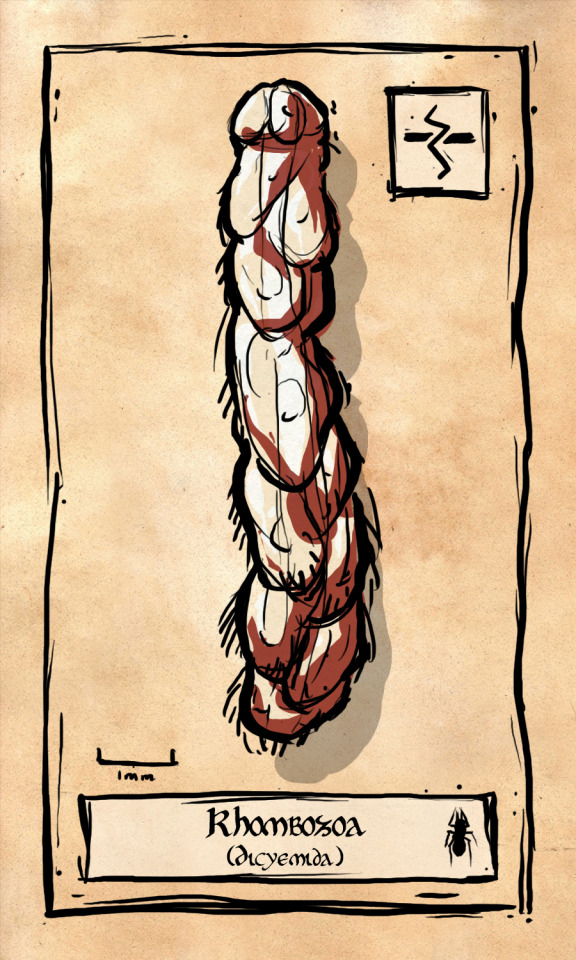


Card descriptions below the cut:
Phoronida – The Horseshoe Worm card represents a return – something that has come full circle to return to its base state. Through change, or perhaps in spite of it, something that has been brought back to light or returned to comfort or perhaps even discomfort. Whether this return is a physical or an emotional one, to home, to health, or a negative one will depend on the subject of the reading. One should tread with caution when return is forecasted, even as a positive, as growth and change are constants in the world of living beings. Phronoids are defined by their u-shaped internal structures that loop throughout their bodies. Both their gut and their bloodstream circle through their body in this way, ending at the same locus of the body.
Placozoa – The Placozoa card represents simplicity. In a reading this should be considered among other elements, and the reading not over complicated by denial and burden. Look to find the most straightforward paths and meanings, and look to find simplicity in life where complexity has overburdened the subject of the reading. The simplest free-living animals in the Kingdom, these animals live and thrive with only four types of cells in their bodies and almost nothing more to their body plan than a top, bottom, and sides.
Platyhelminthes – The Planarian card represents multiple outcomes. While a singular event may seem to be concrete, there are always variations from one singular point. It is not always possible to control these events, but understanding variation that can exist can be critical to understanding an outcome. Embracing variety brings acceptance. When unsure of the outcome of a major or minor event, understand variation, but limit its scope to plausibility. With their simple body plan, flatworms can often survive major trauma, such as bifurcation of the head, by simply growing two heads where once there was one. Despite this change of perspective to the world, the worms remain able to survive and thrive as they inevitably split into two functional individuals from this trauma.
Porifera – The Sea Sponge card represents inner peace. Not just a nebulous form of serenity, but peace from an internally guided source. Looking inward to find a cohesive calm is a tangible and relevant skill at all times, and it may take careful reconstruction of various internal barriers. The sponge, which is both simple and complex, yet can regrow when ground down to its most base cells, is a halcyon of inner peace. With no brain, it lives, and yet does little harm in doing so.
Priapulida – The Penis Worm card represents abundance. As with many other cards, whether this particular meaning is positive or negative is critical to consider within the context of the reading. Abundance can be wonderful when it applies to something of need and value, but abundance can be detrimental when it applies to the over-saturated. Consider where abundance lies in context of the reading, and whether it is something to embrace or step away from. Some species in this phylum may occupy a small area in incredible abundance, their survival strategies allowing them to make the most of favorable environments and produce many offspring.
Rhombozoa – The Dicyemida card represents dispute. In a reading, it may be time to consider where a dispute lies, and be honest in the nature of disagreement. A dispute, argument, or difference of opinion is not, in and of itself unhealthy (although it can be when views are uninformed or cruel) and should be openly considered and allowed to play out as a dispute until a resolution can be reached. When cards in a reading have conflicting interests and meanings and this card is showing, consider where the discrepancy lie, and embrace the differences between them. This phyla encompasses a group of very small and very specific organisms, all renal parasites of squid, although their classification remains in dispute.
Rotifera – The Rotifer card represents the wheel. Wheels turn, they are an embodiment of a perpetual change of states, one to the next to the next, each following the other in an eternal cyclical loop. To live is to change, and yet change comes in cycles, in following forms, in repeated patterns. This is a chance to look at the grater picture of cycles – seasons, orbits, day and night, the repeated and the predictable. Rotifera are so named for the coronal ring which, with its constant motion, superficially resembles a wheel.
Sipuncula – The Fat Inkeeper Worm card represents a net. Creating a net and casting it wide allows to capture many small things at once that may have even avoided capture all together without it. What these small things are depends on the subject of the reading. Ideas? Opportunities? Whatever it is, it may be time to set a net out to catch them up. While the members of this phylum bear a distinct resemblance to a certain portion of human anatomy, their behavior is far more fascinating than a simple phallic comparison. In order to feed, the worm produces a mucus 'net' in its den, filtering water through it, and then consuming it when it is full of prey. It is a highly efficient predator in this way.
26 notes
·
View notes
Text
Hello, my comic book friends!
I have a request to make, and I know there are masterlists out there, so send me those, too. BUT. I'm starting my comprehensive exams for my PhD this year, and I need to narrow down comic book titles for my reading list. I'm analyzing character and character clusters, so I'm wondering what your favorite titles (or, if not favorite, the titles you think are the most interesting) are for the following character clusters:
The Batfamily (Bruce Wayne, Dick Grayson, Jason Todd, Tim Drake, Stephanie Brown, Cassandra Cain, Barbara Gordon, Damian al'Ghul, Kate Kane, Duke Thomas, etc.)
Green Lantern (Hal Jordan, Guy Gardner, John Stewart, Kyle Rayner, Jessica Cruz, Simon Baz, etc.)
Wonder Woman (Diana Prince, Donna Troy, Nubia/Nu'Bia, Artemis Bana Mighdall, etc.)
Superfamily (Kal El, Kon El, Kara Zor-El, Jon Kent, Bizarro, etc.)
Captain America (Steve Rogers, Bucky Barnes, Sam Wilson, America Chavez, Aaron Fischer, Peggy Carter, etc.)
Black Knight (Percy of Scandia, Dane Whitman, Nathan Garrett, etc.)
Captain Marvel (Mar-Vell, Monica Rambeau, Genis-Vell, Phyla-Vell, Khn'nr, Carol Danvers, Kamala Khan, etc.)
If it helps, I'm looking at central characters and their "minor" counterparts, so I am absolutely interested in ensemble stories (e.g., Robin War, Red Hood and the Outlaws, etc.) if you want to suggest them.
Send me some suggestions? Pls?
#comics#dc comics#marvel comics#dc#marvel#dcu#mcu#batman#robin#nightwing#red hood#red robin#batgirl#spoiler#orphan#oracle#batwoman#signal#bruce wayne#dick grayson#tim drake#jason todd#stephanie brown#cassandra cain#barbara gordon#damian wayne#damian al'ghul#kate kane#duke thomas#green lantern
20 notes
·
View notes
Text
Sci-Fi Worldbuilding Project
Codename: Apex
Volume One: The Governments and Factions of Traversed Space (colloquially known as the Traverse)
•The Seven Stars Union: Founded in 2189 after the Splinter of Humanity, the S.S.U started off as a loose federation between several closely linked star systems that eventually grew into a more centralised state. The capital of the S.S.U is the city of Corum on the Planet Ustaar situated in the Kocraton System. Other systems within the S.S.U are Penotar, Acgon, Renur, Olbis, Melinora and Actagan. In recent years the S.S.U has seen increasing tensions with neighbouring Outer Colonial Coalition over Colonisation and Trade Rights. This has lead to the S.S.U increasing its military capacity, though its true strength is its mighty navy which has made it a force to be reckoned with. However unrest within the Seven Stars, has lead to accusations of corruption in government and an increasing number of secessionist movements in the S.S.U
•Outer Colonial Coalition: Founded in the year 2234 after a bloody revolution, the O.C.C is a coalition of Human colonies that felt neglected by other earthly governments and supranational organisations. Bound by a shared ideal of freedom in all forms the O.C.C is incredibly decentralised and adopts a form of direct democracy. The star systems that make up the O.C.C are Phyla, Tannic, Erathane, Polistar and Cantracain. As of the present, the O.C.C has been seeing an increase of Immigrants due in part to the nations recent rapid industrialisation and colonisation of some interstellar bodies. However the O.C.C is often treated as a minor power by many other Stellarnations, with the citizens of the Coalition yearning for a chance to prove themselves on the interstellar stage...
•Commonwealth of Constellations: Founded in the year 2194, the Commonwealth of Constellations or just the Commonwealth began as trade league before evolving into a full fledged nation. Commerce has always been at the centre of the Commonwealths heart, but this reliance on trade has led it to develop a neutral stance amongst other interstellar contenders for fear it's vast trade network may collapse under the pressure war or diplomatic tensions may bring. Within the Commonwealth is also a deep divide between the Rich and the Poor leading to deeply rooted class resentment and tension. The Commonwealth is a true melting pot, home to many species, cultures, ethnicities and religions.
•Interstellar Council of Worlds: Discovered in the year 2241 after Human explorers received reports of unexplained objects entering into various human systems. The I.C.W was formed thousands of years ago by a race of people named the Veritgon. Though now long Extinct the council lives on through the many species it has incorporated into itself now encompassing five spacefaring species and many other "primitives" under surveillance waiting to be uplifted. The Council is lead by a delegation of three representatives from each species equalling 15 members in total. The Council requires any law or motion to gain the approval of at least 8 out of the 15 members while certain matters such as war or emergency responses require unanimous votes. However the Council has grown to become increasingly bureaucratic and decadent and some individuals think a change is in order...
•Asaldon Collective: Discovered in the year 2278 after strange observations of a nearby star were explored by scientists. The Collective is a nation of sentient machines ran by an artificial intelligence who is worshipped as a benevolent deity named "Midon". What makes this machine intelligence unique however is that each individual machine is unique and has its own personality and goals. All share an understanding of each other on a deeper level working together in harmony. The Collective is generally neutral and passive, limited to the three star systems of Vinora, Eridnar and Ecsum. The Collective posses technology far beyond that of any other species with the Asaldon capital world being a living machine made entirely of artificial matter. However there are rumblings the Collective may be stirring trouble as many Industrial machines and androids throughout the Traverse, have been migrating to The Collective, seemingly developing a consciousness. Though this may be attributed to parties unknown...
•Celestial Brotherhood: Discovered in 2311 after mistakenly attacking Interstellar Council of Worlds vessels. The Celestial Brotherhood is a nation of Clans divided into Groups of travellers, traders and warriors. They worship a huge pantheon of Celestial Deities who they believe shaped and birthed the Universe. At the centre of society is "The Brotherhood" acting as a clergy and centre of government amounting to a Theocractic State. Each clan is headed up by a Church which in turn answers directly to the Temple of Lords, the central governmental body and centre of religion within the Nation. In recent years the Celestial Brotherhood has engaged in numerous religious crusades against other interstellar nations but has successfully been repelled at least 5 times. Though rumours are spreading that a 6th Crusade could be around the Corner
•The Consortium: Founded 2353 by numerous interstellar corporations in an attempt to create a corporate paradise. The Nation is entirely ran by a board made up of CEO's and reps from all Members of the Consortium. Poltics is deadly and corruption is high. For a lowly employee to work their way to the top is impossible, with the only viable routes being murder, blackmail and threats. Because the Nation is ran entirely by corporations, Illegal technologies and experiments are frequently ran to avoid the confines of Interstellar Law leading to multiple species rights violations being brought against The Consortium. Recently there have even been allegations of Weapons of Mass Destruction or illegal Biochemical Weapons being manufactured inside Consortium space. With the Consortium rejecting all allegations of course. The Consortium covers the star systems of Incandessa, Uldia, Detral and Peyntis.
•Ilcan Dynasty: Discovered in the year 2341, the Ilcan Dynasty is an ancient interstellar Nation ruled by a wealthy monarchy. The same Dynasty has been in charge for well over a thousand years and holds an iron grip over the Citizens of Ilcan. The Ilcan Dynasty however has been treated harshly by the winds of time, facing disasters such as a Supernova and a devestating meteor impact. Add on top of that a hemorrhaging economy and the Ilcan Dynasty has seen better days. The Nation is stuck in a mindset of blind Nationalism. It used to be the Dynasty were split into various other nations before being united under one banner and over the years this has created an incredibly strong national identity. The cities within the Ilcan Dynasty are ancient, with each iteration being built upon the last. It is a country obsessed with the past, and seeks to impose its dominance upon the Traverse once more.
•Lilacath Star Empire: Discovered in the early 2360s, The Lilacath Star Empire is a huge nation on the borders of The Traverse ruled currently by Empress Isilta. The Empire is surprisingly benevolent, being light rulers and only enforcing a few laws in each star system they occupy. While the head of state is the Empress she has an advisory council called "The Six Sisters" that provide advice and offer their thoughts to the Empress when needed. However the Empress is not obliged to follow The Six Sisters advice. The Empire as of late had halted its territorial expansion and has instead focused on internal cohesion and the building of infrastructure. It currently maintains a peaceful and cooperative stance with the rest of the Traverse. However the exception being the Taurus Nebula Republics and the Dominion of Karth, both of which used to be direct subjects of the Empire who since have been granted independence...
•Taurus Nebula Republics: Discovered at the same time as the Lilacath Star Empire, the TNR is made up of various Republics, each one with a large degree of autonomy over themselves all under the supervision however of a group of 20 elected officials who represent the TNR as a whole. However this heavy decentralisation has often led to vast differences in policy and law which has caused cohesion between the Republics to fracture slightly. Star systems currently under TNR include Kentrum, Qwaut, Zendon, Atholis and Jenstrom. The Taurus Nebula Republics were originally founded hundreds of years ago as they broke away from the Lilacath Star Empire as they rejected all attempts at past cultural and political integration into the Empire, thus causing The Nebulae Wars. From then on The Lilacath Star Empire became very light rulers not wanting to risk another independence movement. Today relations between the two are frosty and both sides have an entrenched cultural hatred towards the other...
•Dominion of Karth: Discovered in the early 2360s, at the same time as the Lilacath Star Empire and Taurus Nebula Republics. It is an isolationist, despotic hellhole founded upon a culture of Deep Xenophobia. Originally "tamed" by the Lilacath Star Empire hundreds of years, their grip on the Dominion was evidently not strong enough and the Dominion of Karth resisted. This caused "The Karthian Scourge" and was a deadly and brutal conflict. The Dominions goal in the beginning was the Genocide of all within the Lilacath Star Empire but alas that never came to pass. The Dominion of Karth managed to severely weaken the Lilacath Star Empire, but were also decimated in return. At the end of the war, High King Selikraa vowed his people would wipe the Lilacath from the Universe entirely and bathe the stars in their blood. Since then they have adopted a policy of strict isolationism, presumably to rebuild and regain their strength. Today we know almost nothing about the Dominion but recent observations have hinted that the Karthians could be preparing to attack again, and unleash the horde on the Traverse...
•Technocracy of Ultar: Discovered in 2392, the Technocracy of Ultar is a nation founded upon the principle that Technology if used effectively, can be a great aid to society and that above all else Science trumps Myth or Superstition anyday. The Technocracy is one of the most advanced nations in The Traverse but not THE most advanced. Their unparalleled scientific advancement however has it's downsides. Denizens live in a perpetual techno-bliss brought on by the latest entertainment and leisure causing a majority of the population to become stagnant. To combat this, the government has begun instituting rewards for those who actively work and limiting the usage of many entertainment machines. There are also sects of Ultar society that wish to an end to the "Science before everything" mantra behind their nation, with some even more radical sects advocating for all Technology to be abolished. Life expectancy within the Technocracy is huge with some living hundreds of years thanks to Ultars advanced medical treatments, having the unintended affect of an ageing population. Recently the Technocracy has worryingly implemented Technology within all newborn babies that could track and monitor a citizens health, aswell as location beginning fears that to combat extreme radicalism within the nation, Ultar will become a police state...
•Grand Imperial Association of Crill: a small fledgling nation founded in 2417 after seceding from the Interstellar Council of Worlds. It only spans a single star system, that being Crill. It is led by a Strategos chosen by the citizens for life, a sort of elective dictatorship if you will. Crill society is split into factions each one being vastly different from the other, leading to frequent civil wars and conflicts. Each faction ultimately has the main goal of having a Stratagos from their faction being elected. Due to its young status as a nation and very small size it is often treated with a very dismissive attitude. The Interstellar Council of Worlds also dismisses the fact that Crill is even independent and still claims to this day it is a member of the Interstellar Council of Worlds. Despite this other nations recognise the Grand Imperial Association of Crill, which can sometimes cause friction with the I.C.W.
•The Kalsaan Hegemony: Discovered in 2399, the Kalsaan Hegemony is a huge melting pot of different species led by a spiritual leader called The Tark. Under the Hegemony, equality in all faucets is priority meaning no privatisation of any sort of business, healthcare or etc. Wealth is equally distributed between all members of society as is Land. However such centralisation has made way for past leaders to consolidate power and rule with an iron fist. To prevent this there are various citizen councils to keep the Tark in check. In recent years the Hegemony has begun a "Glorious Expansion" and has colonised a few neighbouring star systems causing a great amount of controversy over Colonisation rights. But most intriguingly the Kalsaan are expanding incredibly fast, sometimes claiming 5 systems before even colonising 1, causing speculation they may be looking for something...
Additional Notes
•Independent Systems: not all charted star systems in the Traverse are claimed, but instead ran by independent governors or leaders who owe allegiance to no one. Other star systems are off limits due to "Primitive" presence and a wish to not interfere...
Signing off
There we have it. The Nations of the Traverse. Constructive criticism is very welcome as I wanna make this the best thing it can be! The Traverse is a place of Wonder, Beauty and Benevolence, but also Greed, Hatred, Danger and Suspicious activity. As of 2442 it is all that and more, ripe for exploration and storytelling.
1 note
·
View note
Text


So I guess this whole thing was to replace Ronan with someone newer and fresher.
I like Lauri-Ell a lot more than most Kree whose names don’t start with Phyla but I would prefer if she stayed as a fish out of water in Carol’s life longer before getting shoved into a space law enforcement career.
It didn’t feel like her arc was done!
She was literally engineered to be great at violence but didn’t personally like to do violence. And now she’s going to become the Kree judge/jury/executioner in one buff package?
(Spoilers: Teddy appoints her officially off-screen)
There’s good writing you can get out of someone like Lauri-Ell taking on the job but there’s not going to be a Lauri-Ell book. She’s going to be a minor recurring, whenever Kree law needs to be represented. The face of justice in the kinder gentler Hulkling Skrullkree empire.
Of course, I’m mostly disappointed that the job will take her hilarity mostly out of Carol’s life.
I really wanted her to be a present member of the supporting cast
3 notes
·
View notes
Note
What did you think of Mar-Vell in the movie??
Spoilers ahead…

-
-
-
@stars-inthe-sky Well, I knew that if they were going to put him in the movie it would be as a minor character, the movie was going to be about Carol, but they still had to connect her to the kree in some way. I knew that if he was going to be in the movie he wouldn’t die of cancer, or anything, but I still hoped that he could be some kind of a hero (also see his classic suit, the read and blue one, and the negabands, cosmic awareness would have been cool too). After reading ‘The life of Captain Marvel’ I was wondering if the would even mention him in the movie.
I liked how the character inspired Carol, that ‘she’ was someone different from the regular kree and could admire, help and defend other planets and their people (like with Earth, and the Skrulls, etc), that’s something Mar-Vell would have done. I didn’t like the gender change, nothing wrong with female Captains Marvel (I like all of them)but I don’t know, I’ve always seen Mar-Vell as a kree man, he is not a character defined by his gender, but still the character has so few minutes in the movie that it wouldn’t have mattered if he was a man or a woman, why should they change the original character then? And there is the other part, it makes less likely to see Genis, Phyla and Teddy in the future of the MCU. It was already difficult for them, but still… (anyway MCU’s Mar-Vell could have had Teddy with some Skrull Prince, and then she could have met Eros and have some half Kree half eternal children, right?).
17 notes
·
View notes
Photo

[Full size | Process video]
The world of “Draw Your ARMS” is remarkably similar to our own, save some minor differences, and more notably one major one: it is a world where humans never evolved. In their place, the world is populated by various species of anthropomorphic animals known as “zoanthropes,” more commonly referred to as “zoans” for short.
“Zoanthrope” is simply a blanket term applied to all humanoid creatures of advanced intelligence; they can not be properly classified as a single species. The conditions behind their existence are not fully known, but it is believed that they simply evolved covergently alongside their feral counterparts. Feral animals still exist as we know them, and their presence in this world is not considered unusual; a wolf zoan could own a pet dog and no one would raise an eyebrow.
There are both vertebrate and invertebrate zoans, covering multiple phyla and classes. Due to their weight and body structure, there are no zoans capable of flight; however bird, bat, and insect zoans still have vestigial remnants of their wings. Hybrids can exist, but only under proper circumstances and are still uncommon (example: a lion and tiger can have a liger child, but a deer and rabbit can’t have a jackalope). There are no zoans of fictional creatures or domesticated animals (I realize Belle kinda pushes that a bit, but I was specifically thinking more along the lines of domestic cats and dogs and other pets).
13 notes
·
View notes
Text
It’s the end of week 3 already?!
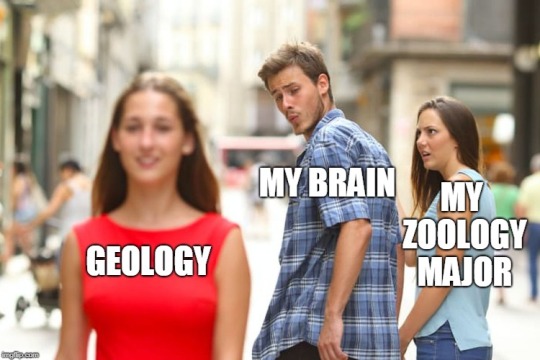
Only my brain would decide to fall in love with geology at almost the last minute (like...there would’ve been 3 semesters to go had my brain not decided to fall hopelessly in love with geology dammit), when I’m halfway through the zoology major. So, that’s definitely gonna be a minor alongside my zoology major for my BSc, since I’m already so far into the zoology stuff anyway, but then again, I want to spread the final year papers over at least three (if not four) semesters, including this semester, so I can have a better handle on workload.
However, for the first time in forever there’ll be music there’ll be light I’m definitely enjoying semester 1 (yay the curse of it always sucking has been lifted!), and so I’m gonna see if I can rank the classes (four all together) in order of “least” liked (I put least in quote marks as I still love the fourth-place paper) to the most liked. But it’s safe to say that Earth and Ocean Science is firmly in 1st place.
4th place: Introduction to Science Communication
It’s definitely an interesting class, but it’s kind of a little too easy and a bit too breezy. However, still likeable, and at least it’s good to have that breezy paper where you can just sail along at a relaxed pace. Maybe a little too relaxed, as sometimes I can almost forget it’s actually in there on Mondays, though not in a bad way. Still a really interesting paper!

3rd place: Behavioural Ecology
It’s another fairly breezy paper, and I love that finally we get to choose a project with anyone we choose to be in our research team (3rd year undergrad papers in zoology are all about the research and fieldwork!) I’m actually really excited about the idea of taking on my first “real” research project in zoology, and I’m surprising myself with how much I’m really taking charge, which I definitely would not have done last year or the years before (no thanks, untreated depression! I feel like you came at the perfect moment in my life, @dand3l1on-fluff when you encouraged me to get help asap last year <3 )
So I guess I really am not that averse to taking charge or leading after all (ditto to what happened in animal designs for living too. I’ll come to that.)

2nd Place: Animal Designs for Living
Honestly, finding about all the adaptations and various phyla of all the animals that have or are on our planet is really fascinating, and definitely can hold hands with geology in terms of paleontology! So yeah, I ship zoology and geology together for that. :D
Also, field trip the other day in the rain by a freshwater river, equipment and group, looking for invertebrates in the river was really fun and definitely the turning point for me realising that I far preferred doing research in the outdoors than inside a laboratory. And sure it was a little chilly, but as Elsa would say, “the cold never bothered me anyway!”...as long as I’m having fun doing it of course.

1st Place: Earth and Ocean Science
This remains the most interesting and fun of all the classes (and that’s for both labs and actual lectures, as well as the weekend day long fieldtrip up to North Otago.) And it has the friendliest staff, demonstrators, and I find it easier to get along with the classmates. While it does cover a broad range of topics (it’s a 1st year class after all), I’m finding it easy to keep up with all the things and it’s not hard to keep up at all. Maybe because my brain can also more easily extrapolate it to other planets/moons inside (and outside!) of our solar system. Also, ocean. Which only makes me get “How Far I’ll Go” in my head.

2 notes
·
View notes
Text
Molecular Analyses used in Genetic Diversity Studies of Bioactive Plants of Verbenaceae and Lamiaceae: A Review- Juniper Publishers

Authored by Arie Fitzgerald Blank
Abstract
Morphological traits used to be employed to differentiate plant genotypes within breeding programs. With the advancement of biotechnology, biochemical markers and DNA molecular markers have become the primary tools used in the differentiation of individuals, because these markers are not influenced by the environment, as it occurs with morphological traits. Consequently, these new techniques provide faster and more precise results. The isoenzymes and the DNA molecular markers RFLP, RAPD, AFLP, and SSR stand out among the biochemical and molecular markers. Each molecular marker presents advantages and limitations, which increases the applicability to different species and laboratory conditions, presenting more reliable results when used in association. Given the increase in the number of works related to bioactive plant species, this review seeks to present the panorama of the use of biochemical and molecular markers in studies on the genetic diversity involving the families Verbenaceae and Lamiaceae, which encompass a large number of medicinal and aromatic species of economic importance.
Keywords: Medicinal and aromatic plants; Genetic resources; Germplasm; Isoenzymes; Genetic markerss
Abbrevations: RFLP: Restriction Fragment Length Polymorphism (RFLP); RAPD: Random Amplified Polymorphic DNA (RAPD); SCAR: Sequence Characterized Amplified Region; SSR: Simple Sequence Repeats; ISSR: Inter-Simple Sequence Repeat; AFLP: Amplified Fragment Length Polymorphisms; PCR: Polymerase Chain Reaction
Introduction
The identification of plant individuals is usually based on the evaluation of morphological and physiological traits, denominated descriptors [1]. These descriptors are usually influenced by abiotic factors, hindering the identification of sufficient characteristics to discriminate genotypically distinct individuals [2].
Biochemical and molecular markers, which are methodologically more specific, have been used in studies on human beings and can also be applied to forensic genetics for providing high-accuracy information [3]. The automation of molecular techniques, provided by the development of the methodology of in vitro amplification of the genetic material by polymerase chain reaction (PCR), led to molecular markers related to the genomic DNA. These markers allow the identification of polymorphism from the amplification of DNA sequences with different sizes, depending on the technique employed. Therefore, these tools provide more efficient discrimination, mainly between morphologically identical but genetically different individuals
Molecular markers can be defined as tools that utilize molecules present in an organism to detect genetic variations. Among these molecules, markers based on variations at the DNA level present greater polymorphism between morphologically-related individuals [4]. There are several types of molecular markers, each one with its advantages and restrictions. They are indicated for specific cases, always considering the available infrastructure. Among the DNA markers available, the Restriction Fragment Length Polymorphism (RFLP), Random Amplified Polymorphic DNA (RAPD), Sequence Characterized Amplified Region (SCAR), Simple Sequence Repeats (SSR), Inter-Simple Sequence Repeat (ISSR), and Amplified Fragment Length Polymorphisms (AFLP) are the most frequently used.
The association of molecular markers with other types of genetic markers is useful for allowing the characterization of various biological materials, generating a potential tool for the characterization of plant germplasm. The families Verbenaceae and Lamiaceae, which hold a large number of species of economic and medicinal importance, can be characterized by markers. These families are made up of bioactive species with several biological properties and are used both in folk medicine and in the drug, food, perfume, and cosmetic industries [5]. Much of this bioactivity is related to the presence of secondary metabolites, such as the essential oils. Essential oils are constituted by a variety of compounds, mostly mono and sesquiterpenes. Biotic and abiotic factors can influence their composition. These metabolites can be used to distinguish individuals belonging to the same botanicalfamily due to the ability of a given group to synthesize a particularset of substances absent in another genus. However, they are notsufficient to genetically differentiate individuals with the samechemical profile within the same species. Morphologically-similarplants with the same chemical profile may not present the samegenotypic constitution. Thus, the essential oils can assist studieson the genetic diversity of populations of the same species.Nevertheless, these metabolites are the result of genetic andenvironmental factors and/or the interaction between them. Inthis sense, molecular markers are an essential tool to complementstudies related to these families since they allow the directassessment of variations in the level of nitrogenous bases in plantgenomes, providing more precise information.
Family Verbenaceae
The family Verbenaceae J.St.-Hil. comprises approximately36 genera and 1000 species. It has a pantropical distribution,occurring mostly in in tropical and temperate zones [6-7]. Brazilholds approximately 16 genera and 250 species [8]. The presenceof glandular trichomes, which produce essential oils of greatmedicinal importance, is a marked characteristic of this family.Some genera have stood out owing to their medicinal uses, such asLantana, Stachytarpheta, and Lippia [9-10].
The use of chemical markers has been reported for the genus Lantana in an analysis of 15 species, revealing (E)-caryophylleneas the major compound and phellandrene, cubebene, and elixeneas minor compounds. However, (E)-caryophyllene was notdetected as the major compound in the genus Lippia. Instead,studies suggested that species belonging to the genus Lippiacontain limonene, citral, carvacrol, β-myrcene, camphor, and thymol as their main chemical markers. In addition to essentialoils, other secondary metabolites can be used to distinguishgenera or families. A taxonomic study of four genera of the familyVerbenaceae (Lippia, Lantana, Aloysia, and Phyla) proposed thepresence of iridoid glycosides as a taxonomic descriptor for thisfamily [11-12].
The genus Lippia contains approximately 200 taxa and 160species of herbs, shrubs, and small trees, many of which are richin essential oils [10,13-14]. These plants are widely distributedin Tropical Africa, Mexico, Central America, Paraguay, Argentina,and Brazil, accounting for approximately 70-75% of the species.Many of the Brazilian species are endemic and are concentratedin the Serra do Espinhaço, Minas Gerais, and Goiás, where theygrow between rocks. Due to their characteristics and to anthropicactivities in these regions, such as mining, these endemic speciesare endangered [7,10,15]. Despite being spread all over theBrazilian territory, reports on the genus Lippia are concentratedin species popularly used in the northeastern region of thecountry. Some of them have been included in the official programsof primary health care [16], with emphasis on the species Lippiaalba (Mill.) N.E. Br. and Lippia sidoides Cham. Moreover, the latteroccurs nation-wide.
Family Lamiaceae
The family Lamiaceae is the largest of the order Lamiales, anorder that includes between 20 and 30 families. Studies on themorphology, chemistry, and molecular phylogeny have changedthe classification of this family, resulting in the addition of a largenumber of genera that had originally been classified in the familyVerbenaceae. As a result, the family has about 240 genera and7,200 species, occurring in tropical and temperate areas aroundthe world. Currently, 32 genera and approximately 496 species arenative to Brazil, although this number is constantly changing dueto new discoveries. Seven subfamilies have been recognized, fiveof which occur in South America. The main genera of the family Lamiaceae native to Brazil include Vitex, Aegiphila, Amasonia,Rotheca, Clerodendrum, Volkameria, Scutellaria, Leonurus, Leucas, Leonotis, Ocimum, Marsypianthes, Hypenia, Eriope, Hyptidendron,Hyptis, and Heltodon [17,18,19].
This family consists mainly aromatic herbs and shrubsthat contain essential oil secretory glands. The plants presentquadrangular stems and opposite leaves, and the inflorescenceshave raceme aspect [20].
This family is one of the most diverse and generalized regardingethnomedicine, and its medicinal value is due to the concentrationof volatile oils, which are important for the pharmaceutical,perfumery, cosmetics, pesticides, and flavoring industries [4,21].Medicinal plants have socio-cultural, spiritual, and medicinalvalue in rural and tribal lives of developing countries [22]. Peoplefrom all over the world use between 50,000 and 80,000 plants formedicinal purposes [23].
Isoenzymatic Molecular Markers
Isoenzymatic markers were the first ones to be used in molecular differentiation between individuals. Despite the irpioneering nature, these markers are usually employed toobtain information related to genetic variability levels in natural populations [24].
From the information contained in the genomic DNA, with thetranslation process, reading of the sequence of messenger RNA(mRNA) for protein synthesis occurs, using polymerization inamino acids peptide bonds. Among the proteins formed, those withcatalytic function are denominated enzymes, being responsible forcatalyzing reactions in an organism in the presence of a specificsubstrate. Some of these enzymes may have the same affinity fora given substrate but different molecular weights, i.e., they aremolecularly distinct enzymes, denominated isoenzymes. Despitehaving the same catalytic functions, they can be biochemicallydifferentiated [25]. Thus, the electrophoresis analysis allowsto visualize and genetically discriminate the isoenzymatic differentiation between individuals, species, and populations.
The isoenzymatic discrimination and its applications haveexpanded in plant genetics research, and the investigation of thepatterns of genetic variability is one of its main characteristics[24,26]. Wild barley [27] and wheat [28] were some of the first studies related to genetic discrimination by isoenzymes. Regardingbioactive plants, two populations of Ocimum nudicaule were thefirst ones to be analyzed by isoenzymes [29].
The identification of variability levels enables the evaluation of the genetic structure in natural populations, which increasesthe efficiency of plant breeding programs and helps the study onthe conservation of native genetic resources [30]. For instance,when assessing the genetic diversity of the endangered species Dracocephalum austriacum, high genetic diversity was identified within populations, which allowed selecting populations that were suitable for genetic diversity conservation [31] and genotypes that could work as parents in future breeding programs.
The diversity and genetic structure of 25 natural populationsof Thymus capitatus, an ornamental plant of the Mediterraneanregion, were analyzed by eight isoenzymes [32]. Elevenpolymorphic loci were detected, and many of them showed rarealleles. These results corroborate studies on isoenzymatic diversityusing other species of the family Lamiaceae [33-34]. Differentiationand genetic similarities between populations indicate they haverecently been isolated by anthropogenic pressure. However,based on the authors’ estimates, most populations showed highvariation, suggesting that the populations constitute suitablegermplasm for conservation and use in breeding programs.
Seven natural populations of Teucrium polium were assessedusing isoenzymes and RAPD regarding their diversity and geneticstructure. The genetic profile within the population had similarresults for both markers. Forty-six electrophoretic bands weredetected by seven isoenzymes, and 144 loci were amplifiedby eight RAPD primers [35], proving to be promising tools forgenotypes characterization.
Despite their efficiency, isoenzymatic markers are limited bythe reduced coverage. Only a small number of loci can be identified by this method. In addition, these enzymes can change dependingon the environmental influence, the plant development stage, and the tissue analyzed [5].
DNA Molecular Markers
DNA molecular markers emerged aiming at samplingdifferent regions of the genome from the structural and molecularknowledge of the deoxyribonucleic acid.
RFLP (Restriction fragment length polymorphism)
At molecular level, the main difference between twoindividuals is detected from the genetic constitution of eachorganism. This difference is the main characteristic that generatespolymorphisms. From this principle, the Restriction FragmentLength Polymorphism (RFLP) was developed [36], being one of thefirst molecular markers based on the DNA molecule. The detectiontechnique of the RFLPs markers uses restriction enzymes,responsible for cleaving the genomic DNA at distinct but specificpoints, allowing the formation of several fragments, whose sizeswill correspond to the target region of the enzyme. The productgenerated is then separated by electrophoresis, visualized byradioactivity, or stained with fluorochromes. The polymorphismvisualized at the end is generated from mutations and alterationsin restriction sites corresponding to the enzyme used.
The RFLP markers are easily reproducible. They have high polymorphism and can differentiate homozygote fromheterozygote individuals. However, the main disadvantage is the lengthy development time and the large amount of high-quality genomic DNA [25].
Different species have been the target of studies with RFLP,which aim to characterize the existing variability. Maize was thefirst plant to be studied using RFLP markers [37,38].
Phylogenetic studies carried out in mangroves using RFLPmolecular markers revealed data that favored the classificationof Avicennia spp., Verbenaceae, into another family, Avicenniaceae[39]. Due to the toxicity present in Salvia divinorum, which canprovoke psychotropic hallucinations, the combination of analyticalchemistry and RFLP molecular methods identified samples of S.divinorum, assisting the forensic and toxicological sciences [40].Moreover, when studying the applicability of RFLP markers toSalvia genotyping, researchers correlated molecular results withlevels of essential oil production. However, their results indicatethe need for further studies on the genetic variations of Salvia [41].
The emergence of plant hybrids is a phenomenon that can naturally occur. Nevertheless, it may affect the performanceand potentiate the extinction of rare species. RFLP markersand morphological analyses were fundamental to distinguishendangered taxa and their hybrids with the exotic plant Lantanastrigocamara.
Lately, the isoenzymatic molecular markers and RFLP havebeen poorly used. Conversely, depending on the species, they may still be useful [42]. Despite their great collaboration at thebeginning of genetic diversity studies of several plant species, they were replaced by more modern techniques, which have greater reproducibility and specificity in accessing species genomes.
SSR (Simple Sequence Repeats)
The SSR microsatellite markers were first described in plantsby Condit & Hubbell [43], who detected the repeats (AC)n and(AG)n. The application of microsatellites as PCR primers was first described by Lieckfeldt et al. [44] and Meyer et al. [45]. Thegenome of eukaryotic species is densely populated by different classes, with repeated sequences and little complexity. The terms Simple Sequence Repeats (SSR) or Short Tandem Repeats (STR)were later replaced by Microsatellite Markers [46-47]. Morgante & Olivieri [48] clarified that microsatellites occurred in 34 plantspecies and that AT repeats were the most commonly detectedclass of nucleotide microsatellites. They also found that themicrosatellite markers were more frequent in the plant speciesthan in invertebrates and fungi and less frequent in vertebrates.
Microsatellite markers are formed by sets of tandem repeats(one after another), with length from two to six nucleotides, andoccur between the most polymorphic loci of the genomes [49,50].
Regions containing SSR are individually amplified by PCRusing a pair of specific primers (from 20 to 30 bases), whichcomplement the sequences flanking the microsatellite. In view of codominance and multiallelism, microsatellites have the highestgenetic information content, which, together with the need for asmall amount of DNA, makes them the ideal genetic markers forgenetic mapping, with higher efficiency for studies on diversity,varieties protection, and assisted selection [51-54].
To use SSR markers, specific primers for the target speciesmust be developed by constructing genomic libraries, selecting and sequencing positive clones, and designing the primers.Subsequently, amplification with PCR, agarose gel electrophoresis,or polyacrylamide is performed, and then the polymorphism isvisualized by staining with silver or fluorescent (polyacrylamide)or with ethidium bromide solution (under ultraviolet light)(agarose). One of the disadvantages of these markers is the high cost for the development of primers [55,56]. However, primersthat have been developed for a determined species can be used in another species of the same genus due to microsatellite sitesmaintained between species [25]. These primers are denominatedheterologous primers. Microsatellites are classified according to the composition of the repeated sequences, as follows: perfectrepeats, without any interruption, such as 12 GTGTGTGTGTGTGT;imperfect repeats, interrupted by bases that do not match the motif, such as GTGTGTGTaGTGTGTT; and compound repeats, atwhich two or more microsatellite repeats (classes) are adjacent toone another, such as GTGTGTGTGTGTCACACACACACA) [5].
A comparative study on the breeding system and geneticstructures of two species of the genus Clerodendrum, using SSRmarkers, resulted in the genetic information and knowledgeabout the taxa, the degree of inbreeding depression, pollen/seeddispersal distance, and pollen genetic diversity on pollinators.In a study on Verbenoxylum reitzii (Verbenaceae), an endemictree of the Brazilian Atlantic Forest, which investigated itsusefulness in population genetic studies, SSR markers revealed high polymorphism, acting as a powerful tool for genetic andphylogeographic studies of populations. The marker was effective,providing genetic information for the development of conservationstrategies for the species [57-58].
In a study with Pogostemon cablin, microsatellite primerswere developed to characterize the Active Germplasm Bank ofthe Federal University of Sergipe. Twelve microsatellites weredeveloped, out of which six were polymorphic. The geneticdiversity was efficiently identified, providing new informationfor research on the species, which will subsidize conservationstrategies and open paths to other studies [59].
Previously developed microsatellite markers and nine others that were later isolated from Salvia officinalis L., an endemicspecies occurring in only two locations in the Balkan Peninsula,were evaluated. Of the 30 markers tested in the natural population,15 were successfully amplified, allowing the comparison of the genetic variation between plants. This study also shows the lessergenetic variation of rare species [60].
Genetic variability analysis was carried out betweenpopulations of Minthostachys verticillata collected in Central and Northwestern Argentina. Ninety-three plants from nine sites wereanalyzed, and results revealed that variability was higher between than within populations. The cluster analysis identified three clusters. The genetic variability observed in the study was higher than that represented in previous phytochemical reports, although the plants are found in the large distribution area, with significantanthropogenic action. The Mantel test demonstrated a positive and significant correlation between genetic and geographicdistance. Applying SSR markers to native species can be useful for the analysis of natural populations, complementing the chemical analysis and developing markers associated with compounds innative species [61].
A study on endangered populations of Origanum compactumrevealed that the Gibraltar strait could have been a plant migrationroute between southern Spain and northern Morocco. Their isolation may have caused the high population differentiation(Fst = 0.22) and low gene flow (Nm = 0.88). These results highlight the importance of developing appropriate conservation strategies for these species, such as partially restoring the geneflow in fragmented and isolated populations that could be quickly extinguished. This technique will be useful for future breeding programs [62].
The genetic diversity and population structure of 18populations of Rosmarinus officinalis, a Mediterranean shrubplant, was analyzed using SSR markers. The authors proposed that the life history and reproductive characteristics contributemainly to explain the high levels of genetic diversity and the weakpopulation structure. Eleven microsatellite loci were polymorphicin all the 18 populations of R. officinalis, totaling 231 differentalleles [63].
With the development of a genomic library, nine microsatelliteprimers were obtained for Lippia alba and used in thecharacterization of the germplasm of the University of São Paulo.Six of them produced polymorphisms, dividing the germplasm intotwo clusters. The data assists the characterization of germplasmbanks, L. alba breeding programs, and other studies on geneticdiversity and classification of species of the genus Lippia [64].
SSR markers were also developed for Phyla scaberrimato determine the genetic variability and population structurepatterns of the species, totaling 11 primers. Fifty-six alleles were detected in 48 individuals belonging to three differentpopulations. The mean number of alleles per locus was 5.09,while the polymorphic information content ranged from 0.000 to0.587. The 11 pairs of primers were also tested for amplificationin six species of the genus Lippia. The transferability rate variedfrom four loci in Lippia florida and L. rotundifolia to six loci in L.corymbosa and L. microcephala. The 11 primers set proved to bevaluable tools for population genetic studies in P. scaberrima andin species of the genus Lippia in which primers transferability was effective [65].
RAPD (Random Amplified Polymorphic DNA)
The Random Amplified Polymorphic DNA was one of the firstmarkers developed after the enhancement of PCR. The RAPDtechnique consists of the use of primers with arbitrary sequences,useful mainly in studies with species that have not been genetically described. It is a rapid technique and has a high potential to detectpolymorphism even with small amounts of available genomic DNA[66]. In this reaction, the primer pairs with the genomic DNA attwo different sites and complements the DNA template. If these primers are located between an amplifiable range-from 300bpto 2.5kb-a DNA product is formed by thermocyclic amplification.Polymorphisms are perceived by the presence or absence ofprimer binding sites and can be detected by agarose gel resolution[67].
Initially, RAPD was used by Williams et al. [68] to constructgenetic maps for several species. Subsequently, according to theneed, RAPD could be adapted to various situations, such as genecoding and identification of resistant genes in plants [69-71]. The RAPD technique became popular for its simplicity, efficiency, and easy performance. Moreover, they do not require information onthe previous sequence [72].
The Random Amplified Polymorphic DNA methodology stands out due to its low cost, practicality, demand for small amounts of DNA, and applicability to species whose genetic material is unknown or presents few isoenzymatic polymorphism. The little knowledge about the genetics of the study species is related to the use of random primers. These primers amplify several regions ofthe genome without prior knowledge of the DNA sequence [73]. Unlike the isoenzymatic markers, whose applicability is relatedto the transcribed regions, RAPD markers have a greater genomerange, amplifying both coding and non-coding regions [74].
The primary limitations of the RAPD technique are the variable reproducibility of results and the limited genetic information perlocus due to its dominant behavior. In other words, the techniquedoes not distinguish heterozygote from homozygote genotypes[25,68].
The RAPD technique was used in a study on the geneticsimilarity and for the construction of fingerprints of a group ofMesona chinensis. Eighteen cultivars and a hybrid were assessedbased on RAPD markers. The study resulted in three primers that could completely distinguish the 19 samples and the similarityindex. The subsequent clustering analysis divided the cultivarsinto five clusters. Moreover, the results of the markers revealed correlations between regional distributions and parental sources.These data provide useful subsidies for the classification,identification, and cultivation of this species [75].
The genetic variability of 11 populations, corresponding tonine species of the genus Lippia (L. corymbosa, L. diamantinensis,L. filifolia, L. florida, L. hermannioides, L. lupulina, L. rotundifolia,L. rosella, and L. sidoides), found in the Brazilian southeast,was assessed by RAPD molecular markers. The analysis wasperformed using 18 primers, generating 490 fragments, of whichonly one presented monomorphic traits for the individuals. Withthe data generated in the analysis, a dendrogram (UPGMA) wasconstructed with two major clusters. In addition, they observedthat the mean interspecific genetic distances were similar for allspecies and higher than intraspecific genetic distances. This resultconfirms the efficiency of the use of RAPD markers in the analysisof genetic diversity for Lippia species and their contribution toconservation and taxonomic implications [15].
In the Anand region, in Gujarat, India, an efficient protocolfor plant regeneration via organogenesis was developed, whichanalyzed the genetic homogeneity of clonal lines established byrandom amplified polymorphic DNA (RAPD) and ISSR of Vitextrifolia species (family Lamiaceae). After the successful plantregeneration from calli derived from stem, leaf, and petiolesexplants, the genetic analysis was performed using the marker. Atotal of 40 seedlings were analyzed using 60 RAPD primers and 27ISSR primers. Of the 60 RAPD primers, 20 were selected, generating125 countable bands. Meanwhile, for the 27 ISSR primers, 12 wereselected, generating 49 bands. The authors concluded that the useof different explants (stem, leaf, and petiole) is advantageous formass propagation and genetic transformation, confirming theefficiency of the RAPD and ISSR techniques to evaluate the natureof regenerated clones of V. trifolia [76].
To understand the genetic variation of three chemotypesof Lippia alba Mill. (Verbenaceae), the cytogenetic analysis ofpollen viability and the nuclear DNA content were evaluatedby the RAPD technique. The authors observed different ploidylevels and mixoploid individuals. Moreover, the flow cytometricanalysis revealed an increase in the nuclear DNA content thatwas not directly proportional to the ploidy level variation. Fortysevenrandom primers were used, of which ten polymorphicprimers were selected. RAPD markers showed that most of thegenetic variation might be a consequence of mixoploidy. Resultsdemonstrated that chromosomal analysis, quantification ofestimated nuclear DNA, and RAPD markers are excellent tools todetect genetic variation between L. alba chemotypes [77].
Another study applied RAPD molecular markers andcompared ITS sequences to estimate the genetic variability ofVerbena officinalis (Verbenaceae), aiming to generate a preciseauthentication method. Results showed that both techniquesallowed the differentiation of V. officinalis from the rest of thegenus, despite the existing intra-specific variation [78].
Nine Ocimum genotypes naturally cultivated in the DakshinDinajpur district, India, were genetically described by RAPDmarkers, which clearly showed that Ocimum africanum andOcimum basilicum are different species. The authors also pointedout that the morpho-chemical and molecular study can be usedas complementary methods in the description of the genotypediversity within the genus Ocimum for its correct identificationand taxonomic classification [79].
ISSR (Inter-simple sequence repeat)
The Inter-Simple Sequence Repeat markers (ISSR) were firstintroduced by Zietkiewicz et al. [80], where the 3’ terminus of theDNA is anchored, and the primers are used to amplify the inter-SSR sequences or SSR flanking sequences. These markers wereemployed to conduct genetic diversity studies [81].
The method employed by the ISSR markers is based on themicrosatellites. They are dominant and do not differ heterozygotefrom the homozygote individuals. However, they analyze multipleloci in a single reaction. Their primers may be anchored at 5’or3’ termini with one to four degenerate bases, based on DNAamplification by the PCR technique. This technique is simpleand efficient due to its high reproducibility and repeatability,generating high polymorphism degree. Its use has becomeincreasingly common. When using primers anchored at the 5’terminus, the amplification products include the microsatellitesequence and its size variations in the genome, providing ahigher polymorphism degree and a larger number of bands [82].No previous knowledge of the genome is required to use thistechnique. Despite being dominant markers, they can be used toassess multiple loci in a single reaction [83,84].
The limitation of this marker is related to the fact that, for beingdominant, the presence of the band can represent the dominanthomozygote or the heterozygote individual, assuming that theabsence of the band is the recessive homozygote. However, thepresence or absence of the band may be related to the occurrenceof insertions or deletions in the primer binding site [80,85]. ISSRprimers are more robust than RAPD primers for they have a largeranchoring surface and higher annealing temperatures, increasingproducts reproducibility [86].
The chemical and molecular characterization of fifteen speciesof the genus Lantana (Verbenaceae) will assist future studies onthe genetic and chemical evaluation of this species and othergenera belonging to the Verbenaceae family, which should includea larger number of species, aiming at a more complete study onthe chemical, genetic, and taxonomic diversity of these plants [87].
A study with twenty-seven accessions of Lippia alba Mill. fromRio Grande do Sul, Brazil, used ISSR and RAPD markers to evaluatethe genetic variability and the relation between accessions. Thegenetic variability was high when compared with that of otherplant species. The UPGMA method showed a low relation betweenaccessions, and no clusters were formed between accessionsbelonging to the same chemotype. The two markers were efficientto evaluate the genetic diversity in L. alba and may contribute tothe conservation and breeding of the species [88].
Savory herb (Lamiaceae) is one of the most relevant medicinalplants of Iran, which is one of the most significant repositories ofSavory germplasm, accounting for about 16 species of the genusSatureia. Ten different populations of three species (Satureiarechingeri, S. khuzistanica, and S. spicigera) were evaluated fortheir genetic diversity using ISSR. Three primers that producedclear and reproducible fragments were selected, generating 19bands. Results of this study revealed that ISSR markers could beused efficiently in the genetic differentiation of the species [89].
A study on Mentha cervina evaluated the morphological,phytochemical, and genetic differences in 12 populations, aimingto obtain the diversity level between them. The relatively lowgenetic diversity detected in the populations analyzed indicatesthat the maintenance of their evolutionary potential is threatenedif population sizes are maintained and if the habitats are notprotected. The amplification of the 121 individuals by ISSRgenerated 175 bands, corresponding to a mean of 82.4 fragmentsper individual. Of these bands, 171 were polymorphic (97.7%).The genetic diversity of M. cervina at species level is relativelyhigh. Conversely, low genetic diversity was detected at populationlevel [90].
In a study with 13 populations of Perovskia abrotanoides,nine selected ISSR primers produced 119 discernible bands, with80.7% polymorphism. The genetic similarity values betweenpopulations ranged from 0.07 to 0.79, indicating a high level ofgenetic variation. The applicability of ISSR markers to characterizethe populations of Perovskia abrotanoides was compared, being thefirst attempt to use molecular markers to investigate the geneticrelationships of P. abrotanoides populations. The informationgenerated can be useful to improve the agro-morphological andphytochemical traits of this species [91].
In a study aiming at the fast and precise identification ofMentha L. species, ISSR markers were used to estimate the genomesize, determine the inter and intraspecific variation within thegenus Mentha, and describe the relationships between genotypes.Thirty-seven ISSR primers were used, which resulted in theamplification of 333 loci and 100% polymorphism. The number ofbands varied from 13 to 24. Moreover, the UPGMA method dividedthe species into seven clusters. These markers are recommendedfor the identification of Mentha L. species/cultivars duringreproduction, conservation, and germplasm collection [92].
The characterization of the genetic diversity of a nativepopulation of Eplingiella fruticosa of the state of Sergipe, Brazil,using ISSR molecular markers revealed an intermediate geneticdiversity. The 100 plants analyzed, collected in 11 municipalitiesof the state of Sergipe, were evaluated by eight ISSR primers,resulting in 72 informative bands. The clustering analysis by theUPGMA method resulted in three clusters. The smallest geneticdistance occurred between plants EPF94 and EPF96 (0.250), andthe greatest distance was detected between the plants EPF50 andEPF96 (0.9778). The polymorphic information content (0.253)was considered moderately informative. These results can supportthe conservation and use of the genetic resources of Eplingiellafruticosa [93].
AFLP (Amplified Fragment Length Polymorphism)
The Amplified Fragment Length Polymorphism (AFLP)markers are based on the selective PCR amplification of total genomic DNA fragments generated by cleavage, using restrictionenzymes. The methodology combines specificity, resolution,and sampling power by the restriction enzyme digestion, beingfast and practical in detecting polymorphisms. This techniquehas been widely used for fingerprinting and genetic mappingpurposes, especially in cultivated plant species that have low DNApolymorphism [94-95].
AFLP analysis consists of four steps: in the first, the genomicDNA of the individual is cleaved by two restriction enzymes; in thesecond, specific adapters are attached to the ends of the genomicfragments generated by the cleavage; in the third, a fraction of thefragments generated is amplified selectively via PCR, using specificprimers designed to recognize sequences in the adapters; and inthe fourth, the subpopulation of amplified fragments is separatedin high-resolution gel [25,96].
One of the advantages of this technique is the detection of highindices of polymorphisms per reaction; also, no prior knowledgeof the DNA sequence data is required to construct the primers[97]. The disadvantage is the lesser information content per locusdue to the dominant nature of these markers, i.e., they do notdifferentiate homozygote from heterozygote genotypes [25].
The diversity and genetic structure of 14 wild populations ofLippia graveolens located in four distinct regions of SoutheasternMexico were analyzed using AFLP markers. Some parameters, suchas the genetic diversity of Nei (Hj), cluster analysis, and Bayesiananalysis were estimated. The authors observed that thymol hadthe highest genetic diversity in the chemotypic analysis. TheBayesian analysis revealed a low but significant differentiationbetween chemotypes. As for the genetic variability, populationsdominated by individuals of the thymol chemotype presentedhigher diversity (Hj = 0.31-0.25) than populations with exclusivelysesquiterpene chemotype (Hj = 0.058). These results confirm thatthe genetic variability influences the chemical profiles, as well asenvironmental and biotic factors, which play an essential role indetermining the structure and the chemotype of this species [98].
The kinship degree and the genetic variation distributionin Tectona grandis (popularly known as teak) cultivated in Côted’Ivoire, were analyzed using AFLP markers. This species iscrucial in afforestation and is exploited uncontrollably due to thequality of its physical properties. In this work, the AFLP markersdemonstrated a clear differentiation between the populationsintroduced in Côte d’Ivoire, showing that they came from NorthIndia [99].
The species Lippia origanoides is economically significantfor the region of the Chicamocha river basin, in NortheasternColombia, due to the quality of its essential oils and to the factthat its distribution is restricted to the few semi-arid areasof Northern South America. By using AFLP markers and 173individuals sampled from four populations, a relatively highgenetic diversity was detected within populations (Ht = 0,32; I= 0,48). Nevertheless, in populations located at higher altitudes,diversity was significantly lower, probably due to more extremeenvironmental conditions. Therefore, the differences in altitudebetween the Chicamocha river basins seem to be relevant indetermining the genetic structure of this species [100].
The chemical characterization of the essential oil components[by gas chromatography/mass spectrometry (GC/MS)] and thegenetic characterization of 27 cultivars of Ocimum basilicum usingAFLP, revealed differences between the morphotypes evaluated.The GC/MS analysis identified 87 volatiles and five chemotypes.The authors stated that a relationship between a geneticprofile, chemical composition, and morphology characterizesa fundamental step to future breeding programs and the in thecultivation of this species [101].
By the AFLP technique, the genetic diversity between tenaccessions of Mentha (Lamiaceae) represented seven taxa andone interspecific hybrid. Six primer combinations were used,generating 2049 bands, of which 1,779 were polymorphic, 29were monomorphic, and 141 were unique. The authors estimatedthe similarity indices and performed the cluster analysis toconstruct a dendrogram, which revealed the kinship degree of thehybrid “Neerkalka” (CIMAP/C63) with one of the accessions (M.arvensis) [102].
Using this same species and technique, the genetic diversityand the genetic relationships between Mentha accessions wasevaluated, aiming at determining the taxonomy of severalinterspecific hybrids. Therefore, 62 mint individuals representingfive species and three hybrids were evaluated. An average of 40AFLP markers was generated, and the percentage of polymorphismranged from 50% to 60% among all accessions studied. Althoughthe number of mint accessions used in this study represents onlya small sample of the mint germplasm available, the AFLP analysishas the potential to be used with a larger number of accessions[103].
The characterization of essential oil variability and the generalcongruence between the chemotype and the genetic clustering ofwild and cultivated populations of Salvia desoleana using AFLPmarkers suggested the existence of a genetic influence on thechemical composition of its essential oil. This information willhelp the conservation and the improvement of the commercialvalue of S. desoleana [104].
In Teucrium arduini, the AFLP analysis separated thepopulations investigated into two clusters, based mainly onthe geographic distance. The Mantel test revealed that thecorrelation observed between the morphological traits and AFLPwas stronger than that detected between the essential oil profileand AFLP. In addition, the test presented a stronger associationbetween the essential oil profile and geographic position thanbetween the morphological traits and geographic position. Thisstudy contributes to the knowledge of the little-investigated floraof the Western Balkan Peninsula [105].
AFLP markers were used to evaluate the genetic variabilityin populations of Phyla scaberrima by AFLP markers. Three combinations of AFLP primers resulted in 997 markers in asample of 131 individuals from five populations (two populationsfrom Mexico and three from Colombia). The low levels of geneticdiversity detected in these populations showed an urgentmanagement strategy must be developed to recover the geneticvariability of the populations from Mexico and Colombia [106].
Conclusion
Molecular markers have contributed significantly to thegeneration of knowledge on bioactive species of the familiesVerbenaceae and Lamiaceae. Several other studies have alsoapplied the ISSR and SSR markers. Such studies help understandthe population genetic structure of poorly studied species andassist the development of conservation strategies and the futureuse of these genetic resources in breeding programs.
To know more about juniper publishers please click on: Juniper Publishers
For more articles in Open Access Journal of Reviews & Research please click on: https://juniperpublishers.com/arr/index.php
To know more about Open Access Journals please click on: https://juniperpublishers.com/index.php
#Juniper Publishers PubMed Indexed#Juniper Publishers Review#Juniper Publishers Indexing Sites#Juniper Publishers
0 notes
Text
Mood Boards Masterpost
Main Characters
Adam Warlock
Aurelian Quill
Cyrus Quill
Eleutherios Quill
Erianthe Quill
Gamora
Hawthorne Rider
Kraglin Obfonteri
Lucianos Quill
Nebula
Peter Quill
Richard Rider
Rose Rider
Minor Charaters
Ayesha
Drax
Elysius
Eros of Titan
The High Evolutionary
J’Son of Spartax
Magus/Goddess
Mantis
Mar-Vell
Meredith Quill
Moondragon
Phyla-Vell
Rocket & Groot
Thanos of Titan
Victoria of Spartax
OTPs
Eros x Meredith Quill
Gamora x Richard Rider
Nebula x Kraglin Obfonteri
Peter Quill x Adam Warlock
Phyla-Vell x Moondragon
BrOTPs
Adam Warlock & Gamora
Gamora & Peter Quill
Peter Quill & Richard Rider
Families
The Quills
The Ravager Girls
The Riders
The Titan Dynasty
The Vells
Teams
The Guardians of the Galaxy
The Infinity Watch
The Nova Corps
Locations
The Quill Home
The Rider Home
The Guardians’ Apartment
Titan
The Sovereign Homeworld
Traditions & Cultures
Sovereign
Spartoi
Titanian
Zen Whoberian
#adam warlock#gamora#nebula#peter quill#ch: adam warlock#ch: aurelian quill#ch: cyrus quill#ch: eleutherios quill#ch: erianthe quill#ch: gamora#ch: hawthorne rider#ch: kraglin obfonteri#ch: lucianos quill#ch: nebula#ch: peter jason quill#ch: rose rider#mch: eros of titan#mch: ayesha#mch: drax#mch: mantis#mch: rocket#mch: groot#mch: meredith quill#mch: the high evolutionary#mch: thanos#mch: moondragon#mch: phyla-vell#mch: mar-vell#mch: j'son of spartax#mch: victoria of spartax
5 notes
·
View notes
Text
Fwd: Conference: Marseilles.24thEvolBiology.Sep22-25
Begin forwarded message: > From: [email protected] > Subject: Conference: Marseilles.24thEvolBiology.Sep22-25 > Date: 25 March 2020 at 06:11:11 GMT > To: [email protected] > > > 24th Evolutionary Biology Meeting at Marseilles September : 22-25 2020 > > The Evolutionary Biology Meeting at Marseilles is an annual congress which > gather together International scientists interested in the mechanisms > of evolution that generate the incredible diversity of living things > found on Earth (and possibly beyond) > > If the congress was initially a local meeting, it quickly gained an > important weight in the scientific life. Indeed, whereas the number > of participants has been increasing, the geographical origin of the > researchers has been diversifying and widening year by year. > > Today, the Evolutionary Biology Meeting at Marseilles has reached a > worldwide dimension and plays a paramount role in the international > scientific life: allowing the gathering of high level specialists, > it encourages the exchange of ideas and stimulates the works of the > researchers all through the world. > > The following subjects will be discussed: > > * Evolutionary biology concepts and modeling; > * Biodiversity and Systematics; > * Comparative genomics ans post-genomics (at all taxomic levels); > * Functional phylogeny; > * Environment and biological evolution; > * Origin of life and exobiology; > * Non-adaptative versus adaptative evolution; > * The « minor » phyla: their usefulness in evolutionary biology > knowledge; > * Convergent evolution > * Evolution of complex traits (Evo-Devo) > > contact Marie-Hélène Rome > > [email protected] > > registration abstract submission see also : web site aeeb.fr or > https://ift.tt/380jRGO > > EvolBiolMeetingMarseilles > > > best regards > > > Pierre Pontarotti DR CNRS > > > > > > PONTAROTTI Pierre >
via IFTTT
0 notes